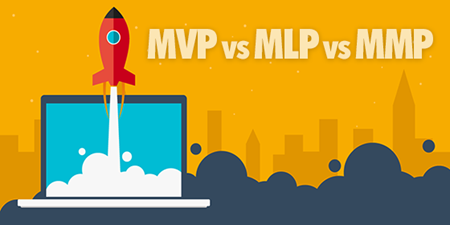The Great Minimum Product Launch-Off
Building a product is hard. Building a truly great product is even harder. In addition, when it comes to working with clients to develop a product - they want it all!

We all know the age old saying when working with clients, “We offer three types of service: good, cheap and fast – but you can only pick two, which ones do you want?”
Cheap + Fast = Won’t be Good - A.K.A Minimum Viable Product
Good + Cheap = Won’t be Fast
Fast + Good = Won’t be Cheap
Balancing the approach of Good vs. Cheap vs. Fast can be tricky, however understanding the ‘minimum product’ that is developed by choosing one of three approaches will be very rewarding.
Many of us are familiar with the concept of a Minimum Viable Product (MVP) - launching a product that delivers your idea to early adopters and gathers feedback for improvements. But how many are familiar with the concepts of developing a more easily sellable product by crafting either a Minimal Marketable Product (MMP) or a Minimum Loveable Product (MLP)?
Many will debate that the MVP is dead, and the MMP and MLP are alive, but when it comes to launching a new product, understand the foundations of these developments, their pros and cons, and help understand which “Minimum Product” approach is best for you.
The MVP, MLP and MMP Concepts
Minimum Viable Product (MVP)
Many of us are familiar with the concept of a Minimum Viable Product (MVP). It was the “OG” when it came to product development. As defined by Techopedia “A minimum viable product (MVP) is a development technique in which a new product or website is developed with sufficient features to satisfy early adopters. The final, complete set of features is only designed and developed after considering feedback from the product's initial users.”
Popularized by Eric Ries - entrepreneur and author of the Lean Startup - this approach launches a product that meets three acceptable criteria:
-
Provides value for early adoption and/or purchase.
-
Provides future benefits to retain early adopters.
-
Provides feedback channels to guide future development.
The Pros of the ‘MVP’ - Minimum Viable Product
-
The acceptance of failing early - That old saying “Failure is never an option” - however when it comes to an MVP, failure is an option. It is better to quit early, cut your losses and not invest into a solution that will not meet user needs, than continue down the path of investing more and developing a product which in the end, no be what the wants.
-
Build a Baseline to Build a Roadmap - Products are never a one and done solution, they are the baseline of the evolutionary product cycle. With an MVP based approach, taking user feedback and feature requests can build out the product roadmap.
The Cons of the ‘MVP’ - Minimum Viable Product:
-
Give me everything - Quoting lyrics of the famous band Queen “I want it all”, one of the most difficult challenges with an MVP is defining what the minimum is. Many factors contribute to the struggle of defining a minimum product and it requires hard decisions to deliver something that isn’t too complex or includes features that users don’t want or need.
-
Be there with Bells and Whistles On - With every release, the feeling is focused on the bells and whistles on and not on ensuring its working correctly. This MVP approach often needs to focus more time is spent on functionality rather than the look.
-
Making it Perfect - Perfection is key.... as we say. When we strive to deliver a product and collect feedback very quickly, most will tend to overlook imperfections. It is important during this time to focus and fix features that have the most impact on both the users and the functionality but not the goal of ensuring there are zero issues.
Some claim that an MVP is an object without a soul.
Minimum Loveable Product (MLP)
A more recent and popular approach to product development is developing and launching with a Minimum Lovable Product (MLP). As defined by Intuit’s founder Scott Cook, a MLP is intended “to deliver a solution that is so extraordinary on the most important dimension that it inspires positive emotion in your customers.”
The intended goal of an MLP is to focus on making a small number of users very passionate about the intended product.
The Pros of the ‘MLP’ - Minimum Loveable Product
-
Become more accountable to Customers - A product development team is more customer-centric and empathetic in all aspects of the design and development phase when the business understands “loveable.”
-
Removes resistance along the Customer Journey - Creating a MLP means designing a product that satisfies a customer interactivity with a brand.
Your Minimum Loveable Product allows you to gain a following while exploring opportunities.
"Don’t make customers happy. Make happy customers."
The catch to this development technique is that it assumes that early adopters can see the goal of the final product and provide feedback needed to help guide the product team moving forward.
That’s why after answering the crucial questions on viability, feasibility and desirability of a concept together, we don’t build an MVP. We build a Minimum Lovable Product (MLP). The MLP has the client’s top couple of features and is beautifully designed. It is appealing. In addition to working great technically, of course.
Minimum Marketable Product (MMP)
Another approach to product development is creating a Minimum Marketable Product (MMP). The MMP is a product which has the smallest feature set that still addresses the user needs and creates the right user experience.
To best understand an MMP, imagine this:
-
You have developed an amazing pie.
-
You have tested the pie at home and with friends and family and they have told you how much they like or love it, but more so how much they dislike and how they would change the pie.
-
You take it away and try to make so many types of pie until you feel this is the one!
Think of it this way: an MMP is a combination of several versions of your MVP. As you improve upon each version, an image of the most efficient and compact form of your product is built.
Ending Notes
Launching a product is daunting, however knowing if the product you’re building is viable, loveable or marketable is harder. The following attributes will help you differentiate an MLP from an MVP and from an MMP:
-
Your MLP should be unique and there should be no products like it on the market – more so in terms of its appeal. This will avoid competition and provide customers with a unique and most importantly a one-of-a-kind experience.
-
You can’t build Rome in a day = developing an MLP is a marathon and not a sprint. Developing customer love does take time. At the early stages, gaining your users interest enough and very much rewarding. Once you have their attention, you can gradually build toward receiving their acceptance.
-
Once a product is introduced, users will contact the business for more information that isn't always available readily.
-
Prospective customers will display visible emotions when you’re describing the product to them, either positive or negative. Don’t be afraid of negative reactions; the most important thing is to avoid neutrality or disinterest.
Using a pie as an example:
An MVP - It may prove that users like your pie, however it may not get people talking about how flakey or delicious your pie filling is. "The version of a new product that brings back the maximum amount of validated learning about your customers with the least effort."
The MLP - It may justify that people love your pie and will confirm they will come back for more, try nay news flavors and tell their friends. This proves they have started small and are impressionable. “The version of a new product that brings back the maximum amount of love from your early tribe members with the least effort.”
The MMP - Understanding the differences in product development approaches will give you the knowledge of how to get your digital ideas to market sooner, but still deliver a product that users fall in ‘viable’, ‘loveable’ or ‘marketable’ with.

Lynette Sawyer
Lynette Sawyer is a Web Project Manager for Falcon-Software, a digital web agency founded in 1994. For the last 13-years Lynette has been in various digital capacities and her expertise goes beyond Project Management. Lynette brings experience and knowledge in graphic design, marketing communications, project management, product management and engagement.